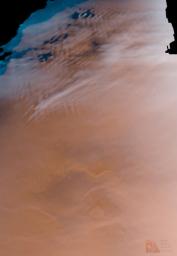Cold and cloudy mornings; cool, hazy afternoons. High winds aloft and weather fronts moving slowly to the east. It is winter in the Martian northern hemisphere. One of the many reasons to study Mars is that, at times, its weather is very "Earth-like." At this time of the Martian year, clouds are abundant, especially in the morning and especially in the high northern latitudes. Clouds and fogs are also observed in low-lying areas farther to the south, in some lowlands they are as far south as the equator.
The above color composite images, obtained by Mars Global Surveyor's camera on June 4, 1998, illustrate this Martian "weather report." Most of the thick, white clouds seen here occur north of latitude 35°N (roughly equivalent to Albuquerque NM, Memphis TN, and Charlotte, NC). Fog (seen as bright orange because it is lighter than the ground but some of the ground is still visible) occupies the lowest portions of the Kasei Valles outflow channel around 30°N and at 25°N.
Several different types of cloud features are seen. The repetitious, wash-board pattern of parallel lines are "gravity wave clouds". These commonly form, in the lee--downwind side-- of topographic features such as mountain ranges (on Earth) or crater rims (on Mars), under very specific atmospheric conditions (low temperatures, high humidity, and high wind speeds). In this area, the wave clouds are lower in the atmosphere than some of the other clouds. These other clouds show attributes reflecting more the regional weather pattern, occasionally showing the characteristic "slash" shape (southwest to northeast) of a weather front. These clouds probably contain mostly crystals of water ice but, depending on the temperature at high altitude (and more likely closer to the pole), some could also contain frozen carbon dioxide ("dry ice").
MOC images 34501 (the red wide angle image) and 34502 (the blue wide angle image) were obtained on Mars Global Surveyor's 345th orbit about the planet. The pictures were taken around 5: 34 p.m. PDT on June 4, 1998. Winter in the northern hemisphere began in mid-February, 1998, and continues to mid-July, 1998.
Malin Space Science Systems and the California Institute of Technology built the MOC using spare hardware from the Mars Observer mission. MSSS operates the camera from its facilities in San Diego, CA. The Jet Propulsion Laboratory's Mars Surveyor Operations Project operates the Mars Global Surveyor spacecraft with its industrial partner, Lockheed Martin Astronautics, from facilities in Pasadena, CA and Denver, CO.

 Planetary Data System
Planetary Data System












